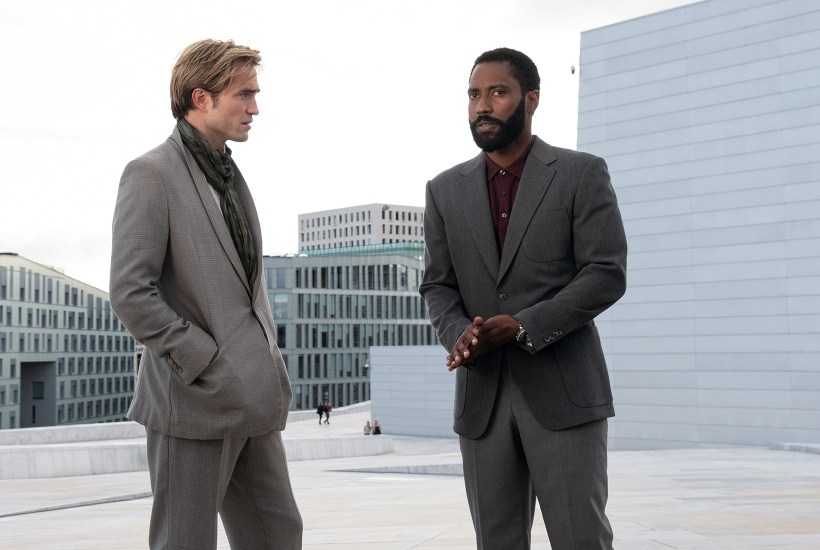Tenet is the latest high-concept, time-bending blockbuster from Christopher Nolan and it’s the film that (unofficially) reopens cinemas in the UK. It has everything that fans of Inceptionor Interstellar might want. There are spectacular set pieces. There’s time going forwards and then reversing, so it’s bullets flying back into the gun as crashed cars right themselves. There is a relentlessly pounding soundtrack. There is Sir Michael Caine playing Sir Michael Caine — his character is called Sir Michael Crosby but I wasn’t fooled — and as for the plot? Incoherent. Which fans seem to like. (‘I can’t explain any of it but it’s genius,’ I heard one say on the radio the other day. ‘A masterpiece.’) I gave up even trying to figure out what was happening an hour into the two and a half hours, and I’d like to say I then settled back to enjoy it — oh look, a high-rise block of flats un-bombing itself! — but once the narrative propulsion was lost I found myself praying for time to move forwards quickly, quickly, quickly. To the end.
This is essentially, I would say, a James Bond film but with added physics no one understands. (I checked. They don’t.) It opens with a prolonged action scene. There are exotic locales and superyachts and those set pieces and a beautiful mysterious woman and sharp suits and an evil Ukrainian and a man-on-a-mission who is also one of those blanks. Intense, but a blank.
He is played by John David Washington and he’s a CIA agent but we don’t know his name other than that he calls himself ‘the Protagonist’. (So meta.) He is made aware of ‘inversion’ — a process by which a person or object can get its ‘entropy reversed’ so that it appears to be spooling backwards as we’re spooling forwards (or something like that). This is explained to him by a scientist (Clémence Poésy) who, I suspect, doesn’t get it either. ‘Don’t try to understand it, feel it,’ she instructs. I’d have preferred to understand it, but there you are. It is all very palindromic, like the film’s title, although it could just as well have been called Kayak. (The Protagonist, having been recruited to a secret organisation, is told that the word ‘tenet’ will open doors for him, but so would ‘kayak’.)
Anyway. Having lunched with Sir Michael Caine (Sir Michael Caine) from British intelligence, for no good reason whatsoever, the Protagonist is given the piffling task of… SAVING THE WORLD! Which, by the end, becomes the piffling task of… SAVING THE WORLD WHILE ALSO RACING AGAINST TIME! WHATEVER TIME IS! Along the way, he picks up a sidekick (Robert Pattinson) and falls in love with Kat (Elizabeth Debicki), the beautiful, mysterious woman who is married to the main villain, Ukrainian arms dealer Andrei Sator, played by Kenneth Branagh at his most cruelly thin-lipped. Sator wants to use entropy reversion to bring the future to war with the present (I think; it is all so, so convoluted) and so his aim is to destroy the world. Wasn’t sure why.
This is trope-heavy. The characters are all tropes rather than proper characters that develop and the rhythm of the film is familiar: set piece, lame joke, set piece, exposition, exposition, set piece, lame joke. And they are truly lame, these lame jokes. ‘I’m usually asked for dinner first,’ the Protagonist quips when he’s frisked before a meeting with Sator. (This is something my dad always said at airports, which is why we all hung back and pretended not to know him.) The script has its horrors too. When Kat asks her husband why he would rather kill her than let her go, he actually says: ‘Because if I can’t have you no one else can.’ If moral complexities were ever explored, they didn’t register with me, but perhaps I’d already clocked out by then.
Got something to add? Join the discussion and comment below.
Get 10 issues for just $10
Subscribe to The Spectator Australia today for the next 10 magazine issues, plus full online access, for just $10.
You might disagree with half of it, but you’ll enjoy reading all of it. Try your first month for free, then just $2 a week for the remainder of your first year.














Comments
Don't miss out
Join the conversation with other Spectator Australia readers. Subscribe to leave a comment.
SUBSCRIBEAlready a subscriber? Log in